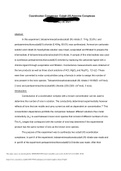Exam (elaborations)
Coordination Complexes- Cobalt (III) Ammine Complexes - lab Reort University of Calgary CHEM 333
Coordination Complexes- Cobalt (III) Ammine Complexes
Anusha Ambaselkar Lab B05 A-1
January 28, 2021
Abstract:
In this experiment, tetraamminecarbonatocobalt (III) nitrate (1.114g, 32.6%) and
pentaamminechlorocobalt(III) chloride (0.454g, 89.0%) was synthesized. Ammonium carbonate
solution an...
[Show more]
Uploaded on
February 11, 2023
Number of pages
8
Written in
2022/2023
Type
Exam (elaborations)
Contains
Unknown
coordination complexes cobalt iii ammine complexes anusha ambaselkar lab b05 a 1 january 28
2021 abstract in this experiment
tetraamminecarbonatocobalt iii nitrate 1114g
326 and pentaamm
All documents for this subject (1)
$8.99
100% satisfaction guarantee
Immediately available after payment
Both online and in PDF
No strings attached
Coordination Complexes- Cobalt (III) Ammine Complexes




